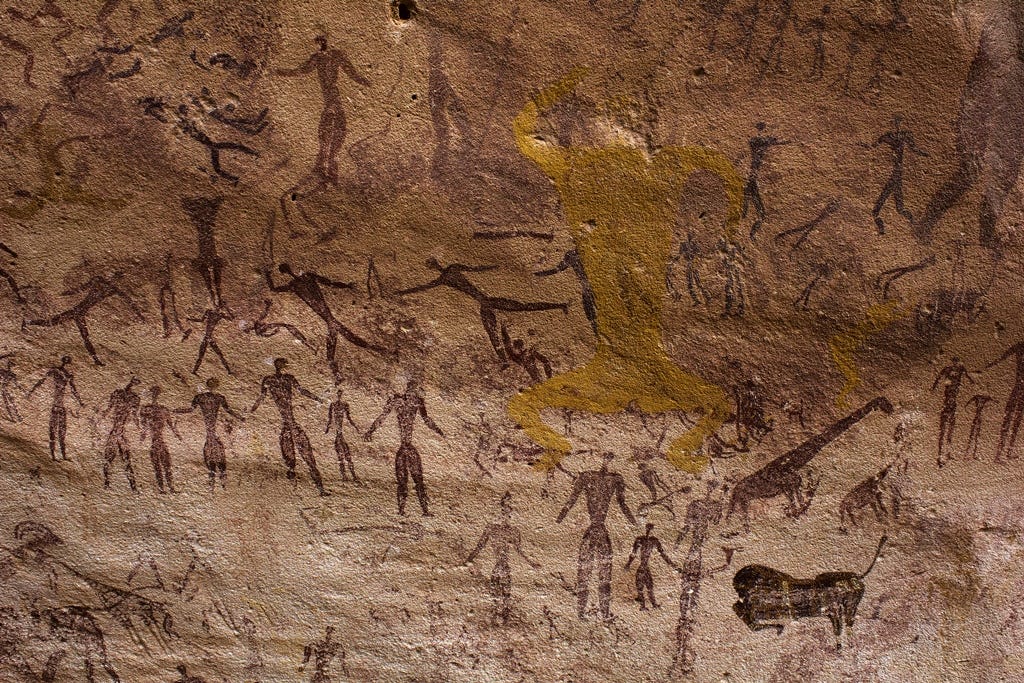Dunbar-scale social
For hundreds of thousands of years, we lived together in small hunter-gatherer bands. We spent most of our lives working, eating, dancing, hunting with the same few dozen people. Periodically, we converged with neighboring bands to party, or fight.

Our wetware reflects this fact. We can keep track of about 150 friends. Who likes who? Who’s fighting with who? Who has a crush on who?
A network of 150 friends has 22,350 relationships to keep track of. That’s quite a few, and the number grows exponentially with the number of friends: (n * (n-1)). The bi-directional network scaling problem. Beyond 150, we start to run up against cognitive limits. This limit is called Dunbar’s Number.

If you live in a hunter-gatherer band, you probably won’t hit this limit. Your social circle is a few dozen people, so you can easily keep track of who’s kind, who’s generous, who cheats, who steals, who shares their food. A repeated game. Webs of trust form organically. You scratch my back, I’ll scratch yours. These reputations get shared through gossip, and the result is a high-trust context, where people can cooperate without really thinking about it.
Beyond 150, you start to run into problems. You can’t keep track of all the players, so free-riders get away with it. Sociopathic behaviors become personally advantageous. This isn’t just true for hunter-gatherers. We see it in contemporary communities, too.
The Hutterites split their communities once they are above ~ 150 because, in their experience, this is the limit at which community cohesion can be maintained without the need for formal laws and a police force to maintain discipline (Olsen, 1987). Forge (1972) arrived at a similar conclusion from an analysis of settlement size and structure among New Guinea horticulturalists. He argued that, in these societies, 150 was a key threshold for community size because basic relationships of kinship and affinity were insufficient to maintain social cohesion when a community exceeded this size.
Dunbar RIM, Sosis R. “Optimising human community sizes”. Evol Hum Behav. 2018;39(1):106-111.
So splitting into smaller communities is one way to preserve trust.
Another option is to hack our wetware to scale trust. We’ve developed a few major hacks so far:
The kinship-based tribe, as denoted by the structure of extended families, clans, and other lineage systems.
The hierarchical institution, as exemplified by the army, the (Catholic) church, and ultimately the bureaucratic state.
The competitive-exchange market, as symbolized by merchants and traders responding to forces of supply and demand.
Ronfeldt, 1996, “TIMN”
These hacks are enabled by, and co-evolve with, related technologies. Language enabled oral storytelling, the recitation of genealogies, and the development of larger kinship networks. Writing enabled hierarchical institutions. Math and money enabled markets. So, these hacks are entangled with particular technological paradigms.
When a new technological paradigm enters the scene, it can be extremely disruptive. Like the printing press being introduced to Europe. You have this late-medieval condition where all these feudal kingdoms are barely held together by a central religious authority.
Now here comes the printing press.
In the fifteenth century everything changes. Human thought discovers a mode of perpetuating itself, not only more durable and more resisting than architecture, but still more simple and easy. Architecture is dethroned. Gutenberg’s letters of lead are about to supersede Orpheus’s letters of stone. The book is about to kill the edifice… In its printed form, thought is more imperishable than ever; it is volatile, irresistible, indestructible. It is mingled with the air. In the days of architecture it made a mountain of itself, and took powerful possession of a century and a place. Now it converts itself into a flock of birds, scatters itself to the four winds, and occupies all points of air and space at once.
Victor Hugo, 1831, “Notre-Dame de Paris”
Belief scattered, and society splintered. This was not an easy transition. There were 200 years of religious warfare after Gutenberg. It took a long time to invent new institutions (democracy, liberalism, science…) that could cope with the new information environment.
Now here comes the internet.
We connect people. That can be good if they make it positive. Maybe someone finds love. Maybe it even saves the life of someone on the brink of suicide. So we connect more people. That can be bad if they make it negative. Maybe it costs a life by exposing someone to bullies. Maybe someone dies in a terrorist attack coordinated on our tools. And still we connect people.
The ugly truth is that we believe in connecting people so deeply that anything that allows us to connect more people more often is *de facto* good. It is perhaps the only area where the metrics do tell the true story as far as we are concerned.
Andrew Bozworth, 2018, in leaked Facebook memo
The internet makes it possible to connect everybody to everybody. Social media leveraged this capability to rapidly bootstrap massive network effects. Facebook alone has 2.91 billion users. That’s greater than the world population, up until about 1960.
But it turns out network effects are a double-edged sword. We’re way past our Dunbar limit. In these conditions, trust is nonexistent, sociopathic behaviors are personally beneficial. There is little incentive to cooperate.
Public social media is overrun by memetic epidemics—bots, trolls, harassment mobs, state actors—the internet of beefs.
We haven’t invented the institutions to cope with this new information environment.
In the meantime, what if we scaled down? We can already see this happening, people retreating to group chats, Discords, Slacks. Smaller, high-trust communities. The Cozyweb. It’s an evolved solution.
When I think about multiplayer Subconscious, I wonder if small, high-trust Dunbar-scale communities might be a good starting point? These are conditions under which an Ostrum Commons can form. Our newer bolt-on forms of social organization are being DDOS'd by the scale of the network, but we're still pretty good at being together in small groups. We evolved for it.




